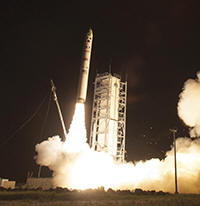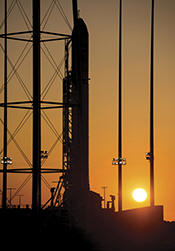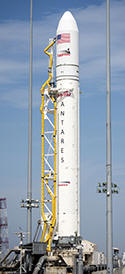|
Wallops Flight Facility Is Becoming a Major Player in
America�s Space Program
Story by Curtis J. Badger, Contributing Writer

Photo
courtesy of NASA/Carla Cioffi
|
On a crisp September morning last fall several dozen
people gathered on the wildlife observation platform in the seaside village
of Willis Wharf on the Eastern Shore.
Willis Wharf is a popular destination for birdwatchers,
as the tidal flats near the harbor attract hundreds of shorebirds for much
of the year. The state built a large viewing platform in 2008 as a means of
encouraging nature-oriented tourism on the Eastern Shore. Most of the folks
who climbed the stairs to the platform had binoculars, and some carried
cameras as well, but it was not shorebirds they were interested in. They
wanted a look at a rare bird of a different feather.
All eyes focused on the horizon to the north, where an
Antares rocket was perched on a launch pad on Wallops Island some 30 miles
away. The Antares was carrying a Cygnus spacecraft destined for the
International Space Station, which was orbiting the Earth with its crew of
scientists. If everything went according to plan, Antares and Cygnus would
deliver its payload of food, clothing, medicine, and research material to
the space station in a few days.
Someone had a radio tuned to WESR-FM, the local station,
which was broadcasting a live countdown to the launch. Excitement grew as
the minutes, and then seconds, ticked away. Suddenly there was a bright
light in the distance, a blue-white fireball surrounded by clouds of steam,
created as thousands of gallons of water flooded the launch pad to mitigate
the heat and shock generated by the rocket. Antares rose slowly, its flame
glowing white hot against the blue sky, and as it began to accelerate the
sound reached us. It was a deep, powerful rumble, the sound of a terrific
force pressing against massive resistance, not at all smooth like a jet
taking off, but a coarse and formidable staccato growl.
Antares gained altitude and its pace quickened. A white
string of vapor marked its flight, and the rocket glowed against the blue
sky like a bright morning star. Even as the roar ended and the vapor trail
wavered on the breeze, Antares continued to glow as it left the Earth many
miles behind, beginning its journey to the International Space Station.

Photo
Courtesy of NASA/Bill Ingalls |
A few people on the viewing platform had seen rocket
launches before, but for many of us, it was our first time witnessing the
launch of a vehicle that would orbit the Earth. Reading newspaper articles
and watching television coverage can in no way relate the excitement, awe,
and, indeed, pride in witnessing the launch of something that is at once
powerful and precise, propelling tons of ship and cargo into space, and
then, days later, docking with an orbiting space station many miles away. It
would have been perfectly fitting if WESR-FM had ended its broadcast with
our national anthem.
Rocket launches on Wallops Island are nothing new. The
first took place shortly after the end of World War II in 1945, and there
have been more than 16,000 since then. But only in the past few years has
Wallops branched out, sending unmanned vehicles to study the atmosphere of
the moon, and launching supply missions to the International Space Station.
And with these newsworthy missions under its belt, the Wallops Flight
Facility has assumed a higher profile. While Wallops once was known mainly
for suborbital research, it now is enjoying life on a bigger stage.
�People began paying attention to
Wallops in 2006 and 2007 when we did the first Minotaur launches from the
Mid-Atlantic Regional Spaceport pad,� says Keith Koehler, Wallops news
chief. �But things really got going when Orbital Sciences Corp. was selected
for the NASA Commercial Orbital Transportation Services (COTS) program and
Commercial Resupply Services contract. Last year they tested the Antares
rocket in April, and in September moved forward with the cargo-supply
mission to the International Space Station. In September we also launched
the first interplanetary mission of the Lunar Atmosphere and Dust
Environment Explorer (LADEE) aboard an Air Force Minotaur V rocket. It was a
spectacular nighttime launch and it was watched by thousands of people along
the Mid-Atlantic coast.�
The emergence of the Wallops Flight Facility and the
Mid-Atlantic Regional Spaceport as a major player in America�s commercial
space program has brought an economic boost to northern Accomack County and
the southern portion of Maryland�s Eastern Shore. The Virginia Commercial
Space Flight Authority developed and oversees the spaceport at Wallops. The
executive director of the authority, Dale K. Nash, told the Chincoteague
Chamber of Commerce in March that the total cost of new development at
Wallops was $145 million. Most of that was spent on construction of launch
pad OA, from which the Antares rocket was launched. The pad cost $120
million to build and took 3� years to construct. The pad was completed in
February 2013, a 30-second �hot fire� test was passed, and six months later
the Antares rocket and Cygnus spacecraft were hauling supplies to the
International Space Station.

Photo
Courtesy of NASA/Bill Ingalls |
The Wallops Flight Facility has created jobs, but the
economic impact goes beyond that. �Over the past year, we�ve been on the
cover of just about everything,� says Keith Koehler. �We gave out media
credentials to 75 to 90 members of the press for the Antares resupply
launch, and we had more than 500 invited guests. Launches definitely bring
people to the area. Our visitor center is busy, even during what usually is
the offseason in winter. We�ve gotten a lot of attention. Any time there is
a major launch it brings in a crowd. It�s difficult to do an exact count
because people are spread out all over the Eastern Shore. There are any
number of good viewing sites.�
The NASA Wallops facility consists of the main base near
the town of Atlantic and the launch site on Wallops Island, about five miles
south. Ron Wolff has a restaurant in Atlantic, about halfway between the two
facilities, and he has seen his lunch crowd swell as the facility has grown.
Wolff credits the success of Wallops to Dr. Billie Reed, the former
director, who envisioned using the facility for commercial space flights.
�Dr. Reed had the foresight to plan for commercial launches, and development
of the spaceport has made it a reality,� says Wolff. �This is now the real
deal. The LADEE missions brought a real economic impact to the area. Then
the contract with Orbital to resupply the space station has solidified the
economic growth that Dr. Reed envisioned.�
Wolff, who represents the Atlantic district on the
Accomack County Board of Supervisors, likes the fact that Wallops brings in
workers from all over the country for specific, temporary assignments.
�These workers rotate in every few weeks, renting homes, cars, eating at
local restaurants, and becoming part of our community,� says Wolff. �The
beauty of this economic windfall for the county is that we do not have to
provide new infrastructure in the way of schools and fire and EMS service,
but we receive all the benefits.�
The growth and success of the Wallops Flight Facility
over the past few years raises an inevitable question. Will the next step
for Wallops be human space flight? Keith Koehler chuckles at a question he
has been asked many times, and he is carefully non-committal.
�Right now Orbital has a contract
to resupply the space station through 2016, and NASA has a commitment to run
the station through at least 2020, so for the immediate future that would
appear to be our mission. But you never know. We would need to add a lot of
infrastructure that we do not have now, and Kennedy Space Center already has
this in place. It�s not beyond the realm of possibility, but it would take a
while to get there.�
To learn about upcoming launches, call the information
line at (757) 824-2050 or visit
http://www.nasa.gov/centers/wallops/events/viewing_launches.html, which also
includes a link for watching launches live via the web.
|
|